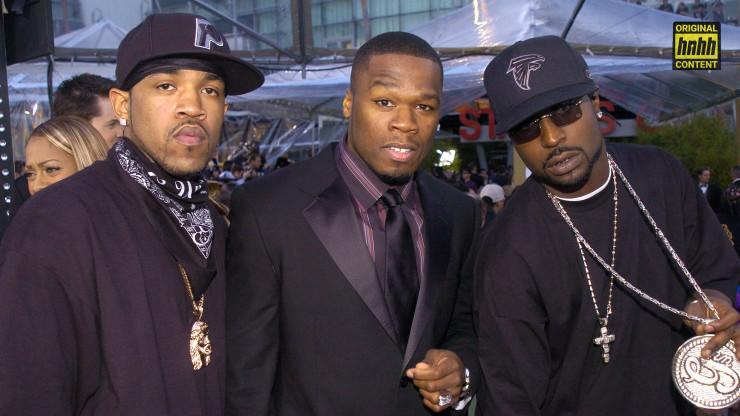
Why Do Rap Crews Always Fall Apart?
 34
34  35
35 The modern hip-hop landscape feels like fertile ground for lone wanderers. Though it wasn’t always. There was once an era in which rap crews reigned supreme, gangs roving the game waving their own respective flags. Especially at the turn of the century. Every superstar seemed to have their own loyal band. Interesting dynamics and standout members proved inevitable — all part of the fun. Any hip-hop head in their late twenties can likely rattle off names like D12, G-Unit, State Property, The Lox, Bravehearts, Disturbing Tha Peace, Tha Eastsidaz, and the St. Lunatics. Some have delivered hip-hop classics; others have faded from memory.
The rap crew has been a mainstay in the game since the late eighties, since Dr. Dre, Eazy-E, Ice Cube, MC Ren, and DJ Yella united to form NWA. Years later came Wu-Tang Clan, arguably the greatest band to ever bless the culture. The product of ten emcees, disparate in styles though united in vision, the Shaolin warriors achieved commercial and critical dominance. Likewise did legendary groups like Bone Thugs-N-Harmony and Three 6 Mafia have untold impact on the culture, their influence on production trends and flow-schemes evident now more than ever. Cam’ron, Mase, and Big L fought record label attention as Children Of The Corn, their movement shattered by Big L’s untimely murder. The Hot Boys, a New Orleans based collective helmed by the notorious Birdman, brought a new bounce to the table. Nas, AZ, Foxy Brown, and Nature joined Dr. Dre for The Firm, a mafioso clique that ultimately floundered under the weight of expectation.

Al Pereira/Michael Ochs Archives/Getty Images
The list goes on. To shine a spotlight on all deserving parties would require far more than a single article. But there is one interesting pattern worthy of exploration, one that really came to manifest in the early millennium. The idea that a commercially successful rapper had a band of little homies waiting in the wings, ready to be put on. Was it a label-fuelled movement? Perhaps; you can bet the Interscope powers that be were salivating at the thought of a D12 album, especially if it didn’t impact Em’s contract as a solo artist. Business aside, the arrival of a crew often introduced new dynamics, undoubtedly fueled by a good-natured sense of healthy competition. Upon listening to D12’s Devil’s Night and St Lunatics’ Free City, there’s a certain edge to both Eminem and Nelly, culminating in some of their rawest and most effortlessly confident work.
Such results wouldn’t be possible without capable colleagues and standout members. For D12, it was Proof, the architect behind the Dirty Dozen’s vision; and of course the gruesome Bizarre, but he’s a standout for reasons beyond technical prowess. For St-Lunatics it was the original schoolboy, Murphy Lee, the high-school prodigy who had a decent solo career in his own right. Those familiar with the group might be quick to vouch for Ali’s prowess, but Murph’s marketability gave him leverage once the crew hype faded. And in most cases, such a fate is not a matter of if, but when. Sadly, rap crews often benefit most from one illustrious centerpiece; if one of the supporting players can find solo success, it’s akin to a late-game Hail Mary catch. Sometimes the buzz is so ridiculous it impacts everyone in the vicinity. It happened to Lloyd Banks, who carved his way from G-Unit’s punchline king to a respectable solo artist with a classic to his name. Young Buck found similar success in his own right, with Straight Outta Cashville serving as a respectable look for the Nashville emcee.

Hiroyuki Ito/Getty Images
Circumstances matter. When a group arises on equal footing, as was the case when Jadakiss, Styles P, and Sheek formed The Lox in the mid-nineties, the established dynamic allowed for a smooth transition into solo waters. Especially for Kiss and Styles, who explored new artistic depths on their debut albums Kiss Tha Game Goodbye and A Gangster And A Gentleman. Such cases skew closer to the Wu-Tang model, in which no discernible skill-based leader is selected by default. It’s the reason The Lox has been able to thrive for as long as they have, despite boasting only three crew albums to their name. Same goes for the Diplomats, who formed in 1997 after the dismantling of Cam’ron’s Children Of The Corn. With Cam, Jim Jones, Freekey Zeekey and later addition Juelz Santana operating on more or less equal footing, the healthy competition from within allowed each member to forge solo careers on their own merit. Sadly, tension ultimately destroyed the group from within, an inherent risk when four capable emcees move forward with no authoritative leader calling the shots.
The rise and fall of the Diplomats echoes that of a newer group, the lyrical powerhouse that is Slaughterhouse. At the time of their formation, Royce Da 5’9”, Joe Budden, Joell Ortiz, and Crooked I were all accomplished lyricists, despite having never sustained long term success in the mainstream. Benefitting from the combined attention of their already established solo fanbases, the group was all but unburdened by the pressure of breaking an artist into the mainstream. The raison d’etre was simple: strive for lyrical excellence in the spirit of hip-hop tradition. Pure in theory, albeit naive: rather than pursuing the mixtape route, the group signed with Shady Records and attempted to reinvent themselves as commercially ble. In this case, it could be said that a case of “too many cooks” brought upon their downfall; others might argue that ego and creative differences played a role. As of this moment, their lost sophomore album Glass House remains an urban myth, forgotten until that one fateful day it leaks from the bluest ether.

Johnny Nunez/WireImage/Getty Images
Such sharp demises are the risk when no clear group hierarchy exists. In some ways, the “little homie” model is the more sustainable option, though the ceiling is significantly lower. Look no further than Ludacris’ short-lived Disturbing Tha Peace family, though it ultimately gave us Tity Boi. Or Nas’ Bravehearts, whose main contribution to the game was “Oochie Wally” — do with that what thou wilt. In hindsight, it’s rare for a group (not to be confused with a duo) to sustain a lengthy and creatively fulfilling career. Even a modern-day quartet like Black Hippy, comparable in many ways to Slaughterhouse, never found the time nor motivation to link up for an album. Heavyweight stars seldom do — does anybody remember the short-lived promise of CRS, the Thom Yorke sampling trifecta of Lupe Fiasco, Kanye West, and Pharrell Williams?
Yet today’s era has brought several exciting movements into the fold. Borne of vision-chasing principles previously seen in the likes of Wu-Tang Clan and The Diplomats yet instilled with a contemporary desire to shift culture, SpaceGhostPurpp’s Raider Klan was among the most impactful early movements to benefit from the internet. In 2008, the hazy and eclectic producer united with artists like Kadafi, Dough Dough Da Don, the late Jitt, and eventually Denzel Curry and Yung Simmie. Drawing influence from their environment of Carol City, Raider Klan’s impact went on to stretch beyond music, encompassing the community and providing like-minded artists with a means of expression. Though with massive collectives of this nature comes another risk, that varying degrees of both talent and motivation will lead to varying degrees of success and sustainability.

David Wolff – Patrick/Redferns/Getty Images
When that does end up happening it need not tear a crew apart. Even as clear standout members begin to thrive as solo artists, some groups remain tethered by a sense of familial loyalty and mutual artistic respect. The A$AP Mob comes to mind, as brought to life by visionary creative Yams in 2006. Inspired by a shared desire to push several facets of artistic culture ranging from music to fashion, the Mob united several like-minded New Yorkers under one banner. Though A$APs Rocky, Ferg, Twelvvy, Nast, Ant, and producer Ty Beats have all experienced different career trajectories, the Mob and by extension Yams’ memory represents a shared ideology above any well-defined creative goals. A similar vibe was felt during the rise of Odd Future, the primary creative outlet for a young Tyler, The Creator. Originally formed in 2007, Odd Future’s formative lineup consisted of Tyler, Hodgy Beats, Jasper, and Left Brain, who quickly found their music gaining steam. As the band of outcasts gained notoriety, Earl Sweatshirt, Domo Genesis, and Frank Ocean added their minds to the creative brain trust. Unlike the Mob, however, Odd Future is more or less inactive, fondly remembered for the spirit they once represented.
And so it goes. Though the rap crew all too often meets an untimely and unamicable end, few go out without leaving a profound impact on the fans. Sometimes, if luck would have it, the dust might even settle to reveal a classic album or two. It’s hard not to look back on all the movements come and gone and not feel a pang of nostalgia. Past, present, or future, what’s your favorite hip-hop crew?



